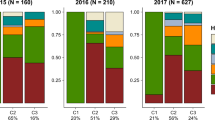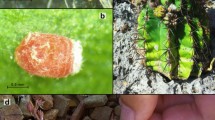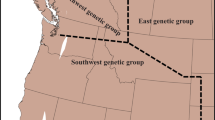Abstract
Speciation in animals is almost always envisioned as the split of an existing lineage into an ancestral and a derived species. An alternative speciation route is homoploid hybrid speciation1 in which two ancestral taxa give rise to a third, derived, species by hybridization without a change in chromosome number. Although theoretically possible it has been regarded as rare1 and hence of little importance in animals. On the basis of molecular and chromosomal evidence, hybridization is the best explanation for the origin of a handful of extant diploid bisexual animal taxa2,3,4,5,6. Here we report the first case in which hybridization between two host-specific animals (tephritid fruitflies) is clearly associated with the shift to a new resource. Such a hybrid host shift presents an ecologically robust scenario for animal hybrid speciation because it offers a potential mechanism for reproductive isolation through differential adaptation to a new ecological niche7. The necessary conditions for this mechanism of speciation7 are common in parasitic animals, which represent much of animal diversity8. The frequency of homoploid hybrid speciation in animals may therefore be higher than previously assumed.
This is a preview of subscription content, access via your institution
Access options
Subscribe to this journal
Receive 51 print issues and online access
$199.00 per year
only $3.90 per issue
Buy this article
- Purchase on Springer Link
- Instant access to full article PDF
Prices may be subject to local taxes which are calculated during checkout



Similar content being viewed by others
References
Coyne, J. A. & Orr, A. H. Speciation 337–342 (Sinauer, Sunderland, 2004)
Dowling, T. E. & Secor, C. L. The role of hybridization and introgression in the diversification of animals. Annu. Rev. Ecol. Syst. 28, 593–619 (1997)
Salzburger, W., Baric, S. & Sturmbauer, C. Speciation via introgressive hybridization in East African cichlids? Mol. Ecol. 11, 619–625 (2002)
Taylor, D. J., Hebert, P. D. & Colbourne, J. K. Phylogenetics and evolution of the Daphnia longispina group (Crustacea) based on 12S rDNA sequence and allozyme variation. Mol. Phylogenet. Evol. 5, 495–510 (1996)
Hirai, H. et al. Chromosomal differentiation of the Schistosoma japonicum complex. Int. J. Parasitol. 30, 441–452 (2000)
Pialek, J., Hauffe, H. C., Rodruigez-Clark, K. M. & Searle, J. B. Raciation and speciation in house mice from the Alps: the role of chromosomes. Mol. Ecol. 10, 613–625 (2001)
Berlocher, S. H. & Feder, J. L. Sympatric speciation in phytophagous insects: moving beyond controversy? Annu. Rev. Entomol. 47, 773–815 (2002)
Price, P. W. Evolutionary Biology of Parasites (Princeton Univ. Press, Princeton, 1980)
Rieseberg, L. H. et al. Major ecological transitions in wild sunflowers facilitated by hybridization. Science 301, 1211–1216 (2003)
Buerkle, A. C., Morris, R. J., Asmussen, M. A. & Rieseberg, L. H. The likelihood of homoploid hybrid speciation. Heredity 84, 441–451 (2000)
Berlocher, S. H. Radiation and divergence in the Rhagoletis pomonella species group: Inferences from allozymes. Evolution 54, 543–557 (2000)
Rehder, A. Manual of Cultivated Trees and Shrubs Hardy in North America 852–876 (Macmillan, New York, 1947)
United States Department of Agriculture. PLANTS Database http://plants.usda.gov/ (2005).
Smith, J. J. & Bush, G. L. in Fruit Flies (Tephritidae): Phylogeny and Evolution of Behavior (eds Aluja, M. & Norrbom, A. L.) 187–217 (CRC Press, Boca Raton, 2000)
Foote, R. H., Blanc, F. L. & Norrbom, A. L. Handbook of the Fruit Flies (Diptera: Tephritidae) of America North of Mexico 322–364 (Comstock, Ithaca, 1993)
Roethele, J. B., Romero-Severson, J. & Feder, J. L. Evidence for broad-scale conservation of linkage map relationships between Rhagoletis pomonella (Diptera: Tephritidae) and Drosophila melanogaster (Diptera: Drosophilidae). Ann. Entomol. Soc. Am. 94, 936–947 (2001)
Falush, D., Stephens, M. & Pritchard, J. K. Inference of population structure using multilocus genotype data: linked loci and correlated allele frequencies. Genetics 164, 1567–1587 (2003)
Barton, N. H. & Hewitt, G. M. Analysis of hybrid zones. Annu. Rev. Ecol. Syst. 16, 113–148 (1985)
McPheron, B. A. & Berlocher, S. H. Segregation and linkage of allozymes of Rhagoletis tabellaria. J. Hered. 76, 218–219 (1985)
Feder, J. L., Roethele, J. B., Filchak, K. E., Niedbalski, J. & Romero-Severson, J. Evidence for inversion polymorphism related to sympatric host race formation in the apple maggot fly, Rhagoletis pomonella. Genetics 163, 939–953 (2003)
Mallet, J. Hybridization as an invasion of the genome. Trends Ecol. Evol. 20, 229–237 (2005)
Fonseca, D. M. et al. Emerging vectors in the Culex pipiens complex. Science 303, 1535–1538 (2004)
Seehausen, O. Hybridization and adaptive radiation. Trends Ecol. Evol. 19, 198–207 (2004)
Floate, K. D. & Whitham, T. G. The “hybrid bridge” hypothesis: host shifting via plant hybrid swarms. Am. Nat. 141, 651–662 (1993)
Feder, J. L., Williams, S. M., Berlocher, S. H., McPheron, B. A. & Bush, G. L. The population genetics of the apple maggot fly, Rhagoletis pomonella and the snowberry maggot, R. zephyria: Implications for models of sympatric speciation. Entomol. Exp. Appl. 90, 9–24 (1999)
Shaw, C. R. & Prasad, R. Starch gel electrophoresis of enzymes—a compilation of recipes. Biochem. Genet. 4, 297–320 (1970)
Niu, T., Qin, Z. S., Xu, X. & Liu, J. S. Bayesian haplotype inference for multiple linked single-nucleotide polymorphisms. Am. J. Hum. Genet. 70, 157–169 (2002)
Simon, C., Bekenbach, A., Crespi, B., Liu, H. & Flook, P. Evolution, weighting, and phylogenetic utility of mitochondrial gene sequences and a compilation of conserved polymerase chain-reaction primers. Ann. Entomol. Soc. Am. 87, 651–701 (1994)
Schneider, S., Roessli, D. & Excoffier, L. Arlequin ver. 2000 A Software for Genetic Data Analysis (Genetics and Biometry Laboratory, University of Geneva, Switzerland, 2000)
Anderson, E. C. & Thompson, E. A. A model-based method for identifying species hybrids using multilocus genetic data. Genetics 160, 1217–1229 (2002)
Acknowledgements
We thank K. Shoemaker and A. Forbes for technical assistance, G. Yatskievich for plant identifications, O. Bjørnstad for comments on the manuscript and help with probability models, and J. Smith, S. Berlocher and L. Rieseberg for comments on the manuscript. Partial funding for this study came from the Pennsylvania Agricultural Experiment Station, the Herbert E. Longenecker Student Research Endowment and the National Science Foundation.
Author information
Authors and Affiliations
Corresponding author
Ethics declarations
Competing interests
The mtDNA COII sequences from the populations of R. mendax, R. zephyria and the Lonicera fly were submitted to GenBank with accession numbers AY846885–AY847000 and AY847015–AY847031. Reprints and permissions information is available at npg.nature.com/reprintsandpermissions. The authors declare no competing financial interests.
Supplementary information
Supplementary Notes
Additional background information on the Rhagoletis pomonella species group; preliminary information on the geographic distribution of the Lonicera fly; and methodology and results of additional data analyses. (DOC 89 kb)
Supplementary Table S1
Literature sources for allozyme data in Table 1 (main text). (DOC 44 kb)
Supplementary Table S2
Allele frequencies at nuclear loci for the Lonicera fly and its parent taxa. (DOC 142 kb)
Supplementary Table S3
Permutation test for deviations from Hardy-Weinberg equilibrium in Lonicera fly populations. (DOC 41 kb)
Supplementary Table S4
Permutation test for deviations from pairwise linkage equilibrium between allozymes in Lonicera Fly State College. (DOC 28 kb)
Supplementary Figure S1
Posterior probability for the assignment of observed Lonicera fly individuals to different hybrid classes that result from two generations of hybridization between R. mendax and R. zephyria. (PDF 135 kb)
Supplementary Figure S2
Comparison of allele frequencies for the most common allele in the Lonicera fly between R. mendax, the Lonicera fly and R. zephyria at seven nuclear loci. (PDF 110 kb)
Supplementary Figure S3
Decay of expected admixture linkage disequilibrium between Aat-2 and Idh in the Lonicera fly under the hybrid-isolation model. (PDF 81 kb)
Rights and permissions
About this article
Cite this article
Schwarz, D., Matta, B., Shakir-Botteri, N. et al. Host shift to an invasive plant triggers rapid animal hybrid speciation. Nature 436, 546–549 (2005). https://doi.org/10.1038/nature03800
Received:
Accepted:
Issue Date:
DOI: https://doi.org/10.1038/nature03800
This article is cited by
-
Early stages of sympatric homoploid hybrid speciation in crater lake cichlid fishes
Nature Communications (2022)
-
Uncovering how behavioral variation underlying mutualist partner quality is partitioned within a species complex of keystone seed-dispersing ants
Insectes Sociaux (2022)
-
Population dynamics and genotypic richness of threatened Acropora species and their hybrid in the U.S. Virgin Islands
Coral Reefs (2021)
-
Evidence of rapid evolution of an invasive poaceae in response to salinity
Aquatic Sciences (2020)
-
Genetic evidence of hybridization between Magellanic (Sphensicus magellanicus) and Humboldt (Spheniscus humboldti) penguins in the wild
Genetica (2020)
Comments
By submitting a comment you agree to abide by our Terms and Community Guidelines. If you find something abusive or that does not comply with our terms or guidelines please flag it as inappropriate.



